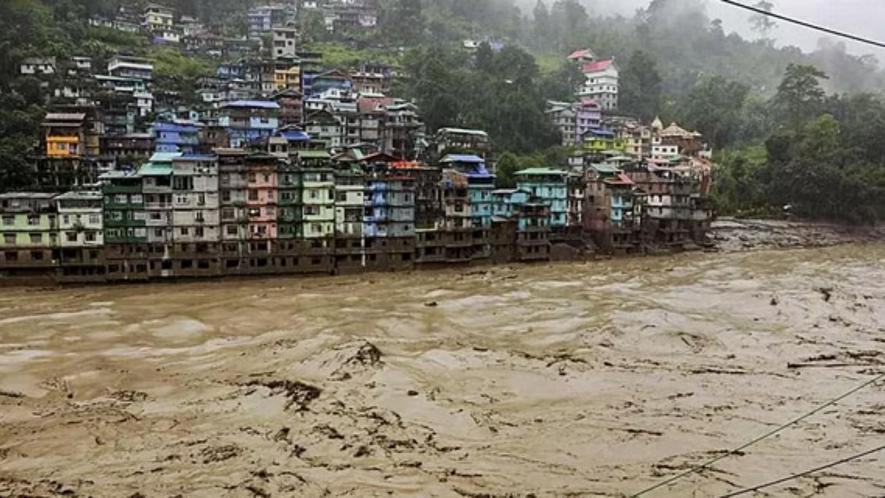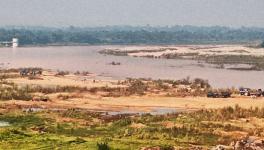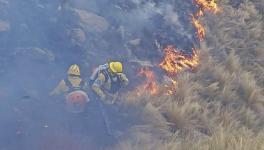‘After Sikkim Disaster…There Should be no More Hydro Projects in Himalayas’

Flooded Teesta river in north Sikkim, Wednesday, Oct. 4, 2023. Image Courtesy: PTI
Earth scientist Dr CP Rajendran, who has specialised in earthquake geology and tectonics, with a special focus on earthquake generation along the plate boundary systems of the Himalayas believes the time has come for the government to undertake a serious reappraisal of their program of indiscriminate construction of hydro projects in the Himalayas. The government agencies also need to step up the remedial action in these vulnerable zones given that the recent Sikkim dam disaster has left scores dead and many missing. A special effort needs to be mounted to develop hazard scenarios and models as well as land zonation maps that demarcate areas prone to floods and landslides. Edited excerpts of an interview with Rashme Sehgal.
India has had three major glacial disasters in the last decade—in Kedarnath, Chamoli, and now in South Lhonak in Sikkim. What do you think has been our learning curve from these disasters?
The Sikkim disaster appears to be a repeat of events like the one at Kedarnath in 2013 and Chamoli in 2021—a sequence of events that marks the increasing risk caused by the upward trend in global warming and sustained melting of mountain glaciers. Combined with unregulated constructions, hydroelectric projects and related anthropogenic activities, these events evolve into massive disasters. Despite repeated glacial disasters in the Himalayas, I don’t think we have made any real progress in learning from previous disasters.
Why do you think lessons have not been learned?
The 2013 Kedarnath glacial lake burst tragedy was a bugle call for preparedness for such hazards. The 2023 Sikkim disaster, which for the first time saw a complete break up of a major hydro project, tells us that the State and the Union governments have been totally ineffective in taking a call. They have failed to take appropriate remedial action in vulnerable areas by ignoring the forecasts made in the scientific studies. Interestingly, the Sikkim Science and Technology Unit itself had been part of a study conducted in 2013.
The Sikkim event is again a reminder that the current predictive capabilities of natural disasters remain underutilised in India. Despite the claims by the official agencies, the Doppler Weather Radars, capable of detecting cloudbursts, are not being properly operationalised and the national disaster communication network and informatics system remain on the drawing board. India needs an online disaster information network that will use archival data on past events in conjunction with current data.
Why do you believe we continue to do firefighting without putting proper procedures and deterrents in place that will help us minimise the impact of such disasters?
The Sikkim disaster shows that repeated warnings of such hazards were ignored. What stands out is the lack of interest and commitment on the part of the governments to engage in consultation with the scientists and take their recommendations seriously.
Much also needs to be done by way of disaster preparedness, along with a sustained outreach programme at its core. The entire stretch of the Himalayas requires special attention in terms of the potential for earthquakes as well as flood disasters.
A special effort needs to be mounted to develop hazard scenarios and models as well as land zonation maps that demarcate areas prone to floods and landslides. At the same time, mega infrastructure projects including highway construction and dam building have been implemented on a war footing without taking environmental impact into consideration.
Human activities should be restricted to safe zones away from the flood plains and maximum river inundation levels.
Today’s computing packages can balance demands on land utilisation with sustainability and provide optimum scenarios within acceptable levels of risk. A realistic mitigation strategy should be based on a blueprint that strikes a balance between development and acceptable levels of risk and economics.
Why are scientific inputs given to the government by leading glaciologists and geologists repeatedly ignored? How does this reflect on our politicians and on our bureaucrats?
The analyses of satellite-borne remote sensing data carried out by various groups of researchers have shown that many glacial lakes in the Sikkim Himalayas have expanded their spatial extent, accompanied by the retreat of glaciers. The expansion of Lhonak and South Lhonak glacial lakes in an interval of 45 years was also found to be significant and both have been flagged as potential GLOF or Glacial Lake Outburst Flood sources.
I can cite several examples including the Char Dham road widening programme or the construction of hydro projects, on which our politicians and bureaucrats don’t take the studied views of the scientists into consideration. Unfortunately, even the courts sometimes follow suit. Most of the decisions of the government are driven by political and short-term financial interests and less motivated by science and long-term welfare measures. From our [scientists’] side, I strongly contend that scientists, as part of their personal commitment to scientific advancement, must also pay attention to how their research and insights are being used by government agencies and in the policymaking process.
To cite an example, the first warning on the increasing size of the South Lhonak lake was given way back in 2001. Its size only increased since then. And then came the inclement weather. What does all this reflect? Is everyone operating in silos?
The first Human Development Report of Sikkim, prepared way back in 2001, discusses glacier retreat and glacial lake outbursts. The joint analyses of satellite-borne remote sensing data carried out in 2013 by the Centre for Development of Advanced Computing in Pune with the Sikkim State Council of Science and Technology also showed that many glacial lakes in the Sikkim Himalayas have expanded their spatial extent, accompanied by the retreat of glaciers.
The expansion of Lhonak and South Lhonak glacial lakes in the 45-year interval was found significant, and both have been flagged as potential lake outburst sources. The Sikkim event was forecast by later studies too, led by the researchers of the Indian Institute of Science. The studies highlight that the length of the glacier that is feeding the lake over the last 29 years has been reduced from 6.4 k to 5.1 km, while the overall glacier shrank by 0.96 sq km. In line with the glacier retreat, the lake has been exhibiting significant growth over the years. It’s a mystery why the Sikkim government has chosen to ignore all these studies. This is also a lesson for the governments in other Himalayan states who are conveniently ignoring the scientific studies that advise against certain so-called developmental projects.
Nine years ago, scientist Dr Ravi Chopra stressed the need to install early warning systems in the hydropower projects being installed in avalanche-prone areas but this has not been done in Chamoli and was not there in the Teesta III dam either. The result is that the crucial 1200-MW Teesta Urja dam was destroyed in ten minutes by the force of the flood waters flowing from the Lhonak Lake. The Supreme Court had also ordered the installation of these early warning systems but it was also ignored. Your comments.
Aside from the Supreme Court, a Parliamentary Committee had raised the issue of the “severe shortage of meteorological and monitoring stations in [the] Himalayan regions”, in its report presented to the Lok Sabha on March 29, 2023.
The impact of this disaster could have been lessened if proper procedures had been followed in opening the dam gates of Teesta III. For that to happen, the Flood Early Warning System should have been functioning. This also raises questions about the engineering design of the dam. Was the Teesta Dam, completed in 2017, an under-engineered structure that was unable to withstand the force of the October 4 flood? If so, who should be held accountable for it?
Scientists have also warned against setting up hydro-power projects above 2,000 metres insisting the upper Himalayan region is unsuitable for such projects.
A number of dams have been built or are being built along the entire stretch of the Himalayas from Arunachal Pradesh to Kashmir—an area most vulnerable to various types of hazards including mega earthquakes. The Sikkim disaster is a strong timely reminder to rethink the various hydro projects being constructed in the region. What would have happened if Teesta V in the downstream part had not withstood the flood waters and instead broken down like the Teesta III? The water unleashed by the two dams would have breached more dams downstream in the Darjeeling part of West Bengal resulting in an unprecedented human tragedy. The Sikkim event compels us to step back and reassess the dangers inherent in building massive dams in the Himalayas.
Could you also talk about questions being raised about the role of the Central Water Commission in not monitoring these floods as carefully as they should have.
The Central Water Commission (CWC) is reported to have maintained flood monitoring stations at some points along the upstream of Teesta. If they had collected data, why couldn’t they issue timely warnings of the oncoming flood? To answer that question, let me quote an excerpt from the report dated March 2023 submitted by the Parliamentary Committee on “Glacier Management in the Country—Monitoring of Glaciers/Lakes including Glacial Lake Outbursts leading to Flash-floods in the Himalayan Region:
“CWC is the nodal organisation for providing information on riverine flooding. The flood forecasting process of CWC has a Standard Operating Procedure (SOP) which is scrupulously followed. This SOP is updated twice every year during April and September. Also, for handling the crisis related to and to forewarn the appropriate administrative authority for responding to a flood emergency due to heavy rainfall, dam break, glacial lake outbursts, landslide dam breaks, releases from dams etc, Crisis Management Plan (CMP) of the Union Ministry of Jal Shakti (Department of Water Resources, RD&GR) has been formulated. In case of any such crisis, the protocols given in CMP are strictly followed. The CMP is updated annually.”
If the SOP is in place and flood forecasting measures were foolproof as claimed by the CWC, then why was the Sikkim crisis handled so shoddily by the concerned agencies? Obviously, much needs to be done to maintain an all-weather monitoring system in these regions. If an operational early warning system was in place, the South Lhonak Lake outburst would not have evolved into a disaster.
With glaciers rapidly receding. The number of glacial lakes is rising and the danger from them is only going to increase. What action should the government take to prevent a repeat of these tragedies?
The Sikkim disaster and the previous ones in Kedarnath and Chamoli are human-made—a consequence of ill-planned constructions and lack of preparedness despite warnings and forecasts. There should be a serious rethinking of the developmental models for the Himalayan states in the context of climate change and earthquake potential. A decentralised and participatory planning process must be put into practice by bringing the major stakeholders—the people—on board for their feedback, rather than following a top-down command system, that too in the background of climate change, ecological vulnerabilities, and sustainability.
The Parliamentary Committee I previously mentioned, in its report on glacier management, while discussing glacial lake outbursts, conveniently chose to be silent on the massive infrastructure projects like road-widening and dams being constructed in the Himalayan terrain, which compound the effects of glacial floods and avalanches.
To this, we may also factor in the potential for damaging earthquakes. Without further ado, we must put a stop to the construction of all hydro projects in the Himalayas. There should be no more hydro projects in the Himalayas and attendant constructions of tunnels or widening of the roads. The Sikkim disaster disproves the argument that the hydro projects are harmless and environment friendly. To quote the UN Secretary-General António Guterres at the 2019 Climate Action Summit: “Nature is angry. And we fool ourselves if we think we can fool nature. Because nature always strikes back. And around the world, nature is striking back with fury.”
(Rashme Sehgal is an independent journalist.)
Get the latest reports & analysis with people's perspective on Protests, movements & deep analytical videos, discussions of the current affairs in your Telegram app. Subscribe to NewsClick's Telegram channel & get Real-Time updates on stories, as they get published on our website.























